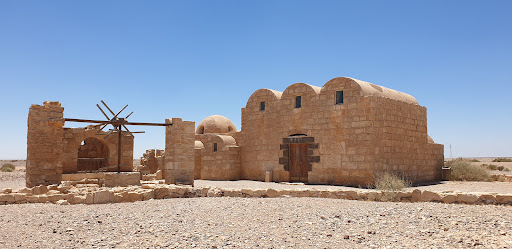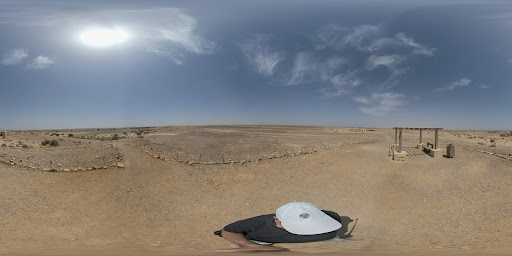Qusayr 'Amra or Quseir Amra, lit. "small qasr of 'Amra", sometimes also named Qasr Amra (قصر عمرة / ALA-LC: Qaṣr ‘Amrah), is the best-known of the desert castles located in present-day eastern Jordan. It was built some time between 723 and 743, by Walid Ibn Yazid, the future Umayyad caliph Walid II, whose dominance of the region was rising at the time. It is considered one of the most important examples of early Islamic art and architecture.
The building is actually the remnant of a larger complex that included an actual castle, meant as a royal retreat, without any military function, of which only the foundation remains. What stands today is a small country cabin. It is most notable for the frescoes that remain mainly on the ceilings inside, which depict, among others, a group of rulers, hunting scenes, dancing scenes containing naked women, working craftsmen, the recently discovered "cycle of Jonah", and, above one bath chamber, the first known representation of heaven on a hemispherical surface, where the mirror-image of the constellations is accompanied by the figures of the zodiac. This has led to the designation of Qusayr 'Amra as a UNESCO World Heritage Site.
That status, and its location along Jordan's major east–west highway, relatively close to Amman, have made it a frequent tourist destination.
History
Construction: who and when
One of the six kings depicted is King Roderick of Spain, whose short reign (710-712) was taken to indicate the date of the image, and possibly the building, to around 710. Therefore, for a long time researchers believed that sitting caliph Walid I was the builder and primary user of Qasr Amra, until doubts arose, making specialists believe that one of two princes who later became caliph themselves, Walid or Yazid, were the more likely candidates for that role. The discovery of an inscription during work in 2012 has indeed allowed to date the structure to the two decades between 723 and 743, when it was commissioned by Walid Ibn Yazid, crown prince under caliph Hisham and his successor for a short reign as caliph in 743-744.
Both princes spent long periods of time away from Damascus, the Umayyad seat, before assuming the throne. Walid was known to indulge in the sort of sybaritic activities depicted on the frescoes, particularly sitting on the edge of pools listening to music or poetry. One time he was entertained by performers dressed as stars and constellations, suggesting a connection to the sky painting in the caldarium. Yazid's mother was a Persian princess, suggesting a familiarity with that culture, and he too was known for similar pleasure-seeking.
Key considerations in placement of the desert castles centered on access and proximity to the ancient routes running north from Arabia to Syria. A major route ran from the Arabian city of Tayma via Wadi Sirhan toward the plain of Balqa in Jordan and accounts for the location of Qusayr Amra and other similar fortifications such as Qasr...
Read more Learn more insights from Wanderboat AI.
Learn more insights from Wanderboat AI.










